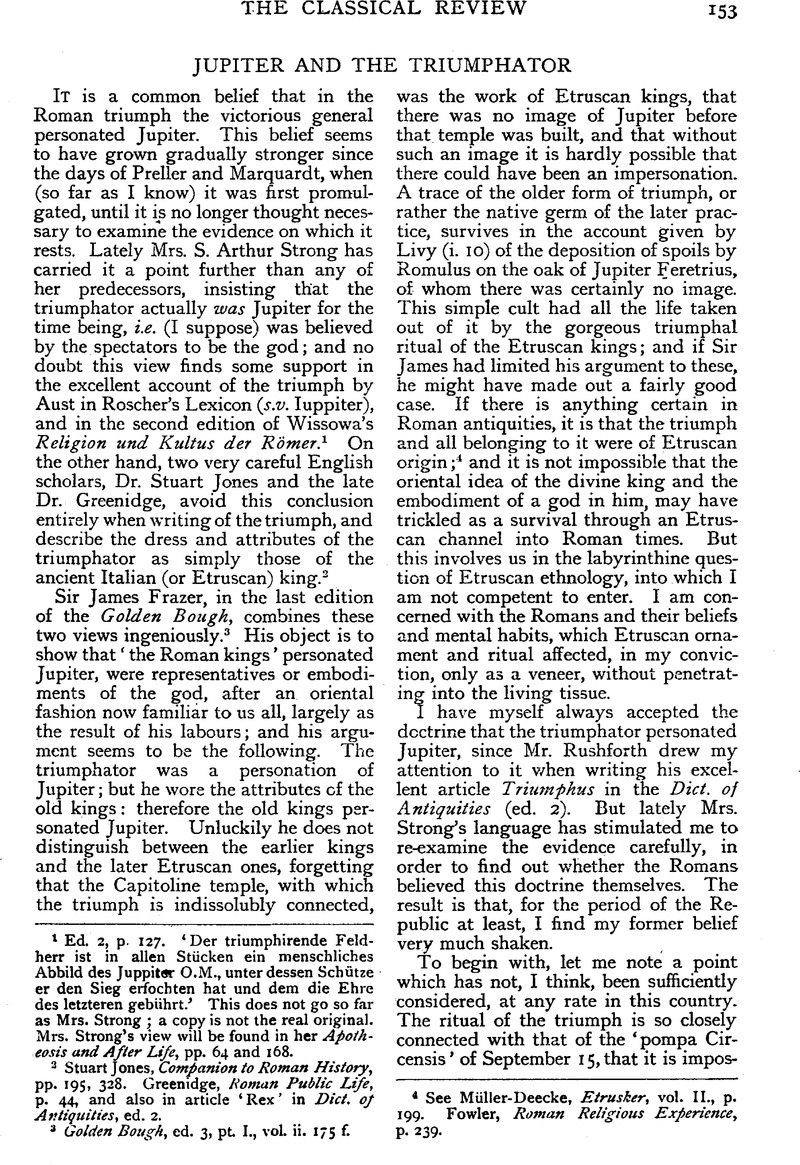Article contents
Jupiter and the Triumphator
Published online by Cambridge University Press: 27 October 2009
Abstract

- Type
- Original Contributions
- Information
- Copyright
- Copyright © The Classical Association 1916
References
page 153 note 1 Ed. 2, p. 127. ‘Der triumphirende Feldherr ist in alien Stücken ein menschliches Abbild des Juppiter O.M., unter dessen Schütze er den Sieg erfochten hat und dem die Ehre des letzteren gebührt.’ This does not go so far as Mrs. Strong; a copy is not the real original. Mrs. Strong's view will be found in her Apotheosis and After Life, pp. 64 and 168.
page 153 note 2 Jones, Stuart, Companion to Roman History, pp. 195, 328Google Scholar. Greenidge, , Roman Public Life, p. 44Google Scholar, and also in article ‘Rex’ in Dict. of Antiquities, ed. 2.
page 153 note 3 Golden Bough, ed. 3, pt I., vol. ii. 175 f.
page 153 note 4 See Müller-Deecke, , Etrusker, vol. II., p. 199Google Scholar. Fowler, , Roman Religious Experience, p. 239.Google Scholar
page 154 note 1 See Roman Festivals, p. 216 and reff. Liv. 45–39.
page 154 note 2 Liv. v. 41, where ‘tensas ducentibus’ indicates the ritual of the ‘pompa.’ Cf. Liv. x. 7.
page 154 note 3 Juv. x., 36 f., and Mayor's elaborate note: Aust, p. 736 b.
page 154 note 4 Most of these passages are cited by Aust in Roscher's Lexicon, s.v. Iuppiter, p. 726 at top.
page 154 note 5 Liv. xxx. 15. Cf. xxvii. 4, where Syphax and other ‘reges’ are thus honoured.
page 154 note 6 Liv. x. 7: ‘Quod cum ita se habeat, cui deorum hominumve indignum videri potest, inquit, eos viros quos vos sellis curulibus, toga praetexta, tunica palmata, et toga picta, et corona triumphali laureaque honoraritis, quorum domos spoliis hostium affixis insignes inter alias feceritis, pontificalia atque auguralia insignia adiicere? Qui, Iovis optimi maximi ornatu decoratus, curru aurato per urbem vectus in Capitolio ascenderit, si conspiciatur cum capide ac lituo, capite velato victimam caedat, auguri-umve ex arce capiat?’
page 155 note 1 Juv. l.c. Serv. ad Ecl. x. 27. Servius writing in the fourth century A.D. under the influence of philosophy and imperial apotheosis, has travelled far beyond the old Roman ideas of the triumph: ‘Aether autem est Iuppiter. Unde etiam triumphantes, qui habent omnia Iovis insignia, sceptrum, palmatam togam, qua utebantur illi qui palmam merebantur. Unde ait Iuvenalis,’ etc For three centuries before Servius wrote this, the triumph had been a monopoly of the emperor and his family. ‘Exuviae’ seems only to be used of the god's dress in the ‘pompa’: Festus 500, ed. Lindsay.
page 155 note 2 Festus, p. 228, ed. Lindsay.
page 155 note 3 Plutarch, Marius, 12 ad fin.
page 155 note 4 Vita Alex. Severi, 40; Julius Capitolinus, Gordiani tres 4. 4. These passages are usually referred to (not quoted) to prove that the triumphator figured as Jupiter; when examined they appear to be no proof at all.
page 155 note 5 Plin. H. N. 33. 111. Serv. Ecl. 6. 22; 10. 27. The learned Servius gets out of his depth under the impression that red was the ‘color aetherius.’ Pan had his face smeared red for this reason, ‘propter aetheris similitudinem.’ He evidently knew nothing of the practice except from books, and I suspect that in his time (fourth century) it had fallen out even in the case of emperors.
page 156 note 1 Serv. Ecl. 6. 22. Plin. 35. 157.
page 156 note 2 Tib. ii. 1. 55. On the general question of the use of red in ritual, see references in a note on p. 89 of my Roman Religious Experience.
page 156 note 3 Apotheosis and After Life, pp. 64 and 163.
page 156 note 4 Dionysius, ii. 34.
page 156 note 5 Aen. xii. 161 f.
page 157 note 1 The notion about Jupiter and Sol must have arisen from Livy v. 23, where Livy writes of Camillus that in his triumph he exceeded all previous magnificence, using even white horses; ‘Iovis Solisque equis aequiperatum dictatorem in religionem etiam trahebant.’ This is merely a rhetorical device to give point to the complaints; it was of course impossible that Livy should have had any information other than legend. Dio Cassius tells us that the Senate expressly voted white horses to Caesar for his triumph (43. 14), which makes it probable that they had not been used before. By that time no doubt they might be called, as Livy calls them, ‘Iovis Solisque equos.’
page 157 note 2 See von Domaszewski, , Die Religion des Römiscken Heer, p. 12Google ScholarCf. Dionys. iii. 61; the eagle was given to the older Tarquin by Etruscan cities as a mark of his kingship.
page 157 note 3 Aust in Roscher's Lexicon s.v. Iuppiter, p. 726. I have examined the evidence there adduced, which seems sufficiently sound.
page 157 note 4 Suet. Aug. 94.
page 157 note 5 Dict, of Antiquities, vol. ii., 897 B.
page 157 note 6 Tertullian, , Apol. 33; Juv. x. 41.Google Scholar
page 157 note 7 Prof. Gardner has kindly made search for me, but so far without result. Aust and the German writers on the subject, who use the evidence of coins freely, never allude to any work of art in which the triumphator wields the bolt.
- 1
- Cited by




